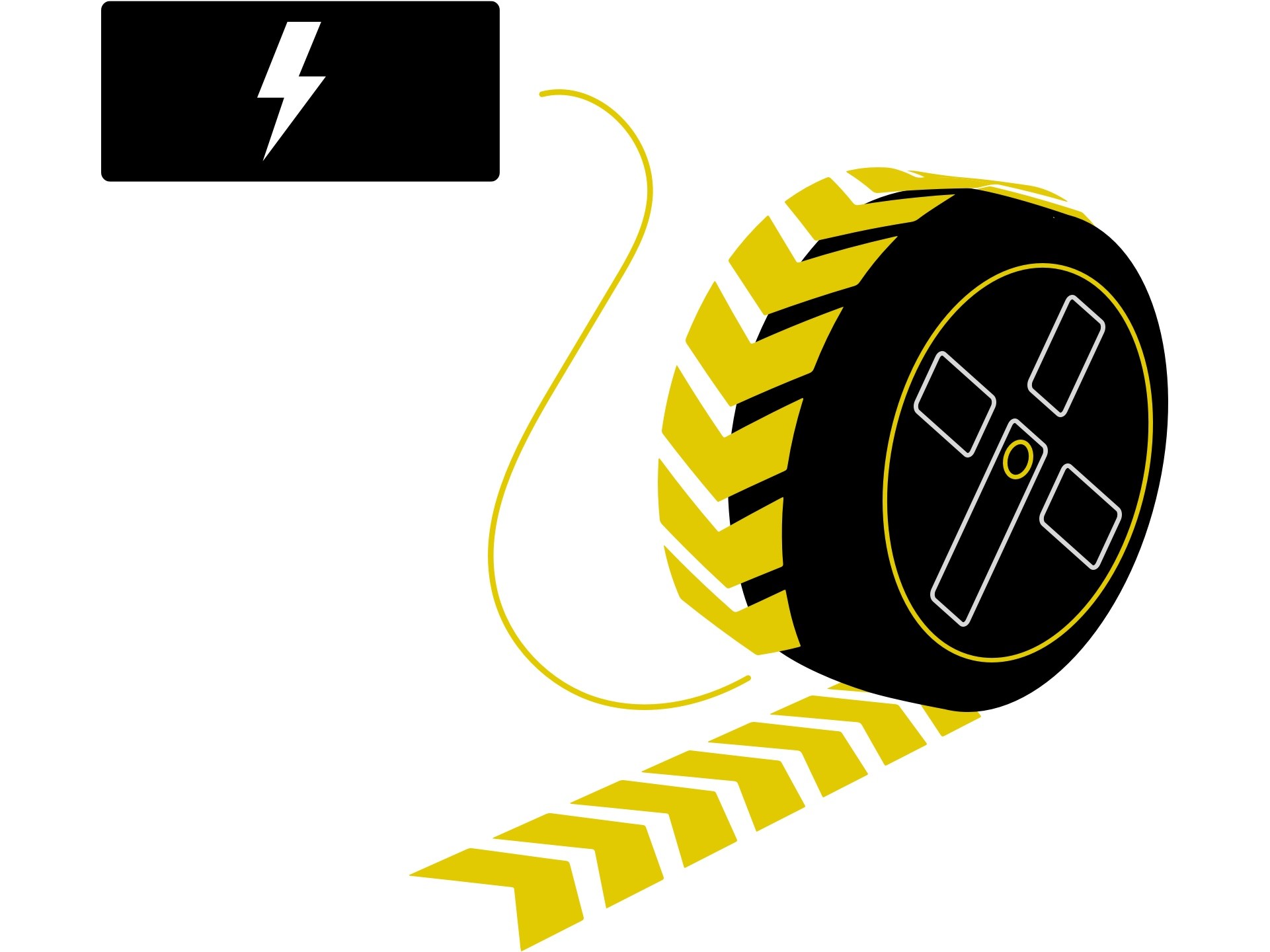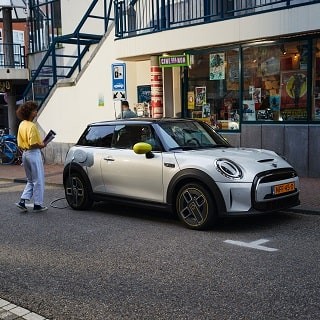Our tool for managing your permission to our use of cookies is temporarily offline. Therefore some functionality is missing.
ELECTROMOBILITY.

GO FURTHER DOWN THE eROAD.

WHAT FACTORS AFFECT THE RANGE?

BATTERY SIZE.
Generally, the greater the battery capacity, the longer you can drive. But that's not the complete story.
Batteries are the heaviest and most expensive component of an electric vehicle. And there comes a tipping point where a bigger battery requires a more powerful motor to achieve the same acceleration rate – and a stronger chassis and brakes to control the speed, weight and momentum. It is therefore crucial that we strike an optimal balance between weight and range to get the maximum efficiency and efficacy out of the resources we use.

How can you prolong your EV battery's life?
Avoid keeping your car sitting with a totally full or empty charge. Best case would be keeping your SOC between 20–80% particularly when leaving it for longer periods – and only charge it fully for long distance trips.
Minimise the use of fast chargers (DCFC). Some high-use duty cycles will need a faster charge, but if your EV charges overnight Type 2 should be sufficient for the majority of your charging needs.
Climate is out of your control, but do what you can to avoid extremely hot temperatures. You can at least try to park in the shade on hot days.

ENVIRONMENT FACTORS.
A number of factors can influence the range of an electric vehicle.
- Wind
- Speed (own head wind)
- Aerodynamics
- Windows and panoramic roof
- Temperature
- Air density (can affect battery)
While the same factors can affect every vehicle, no matter what the drivetrain, they have a far more noticeable affect on EVs.

HOW TO DRIVE EFFICIENTLY.
DRIVE WITH FORESIGHT.
Recuperation.
All-electric vehicles can utilise their electric motors to decelerate and convert kinetic energy back to electric power for the battery. This regenerative braking process is called recuperation.
One pedal driving.
MINI Electric offers the option of one-pedal driving. If you step on the the 'gas' pedal you accelerate. Lift off your foot and you brake. But this is no four-wheel, lock braking, but a steady deceleration which you can amplify as necessary with the brake pedal.
In general, if you want to make the most of every watt, try to decelerate as much as possible without using the braking pedal. This energy generation improves fuel efficiency and ensures that the full power of your engine is available for acceleration. It is worth taking an extra spin or two to get the feeling for this recuperation and not using the brake pedal.


DRIVE SMOOTHLY.
Aggressive driving – rapid acceleration and hard braking – wastes energy. Even with regenerative braking, the system can only regain some of the power. If you want to use your energy efficiently, just relax, enjoy the smooth dynamics, and glide through the city.
USE THE DRIVING MODES.
Each driving mode tunes the system differently to accentuate fuel economy or performance depending on your selection. It is worth taking a few drives to get familiar with the characteristics of the different driving modes and take advantage of the options. All electrified MINIs are equipped with driving modes.


HOW TO PLAN FOR A LONGER TRIP.

KNOW YOUR ROUTES.
Check for charging stations en route.
Take a look at a charging map, before leaving to get an overview of your options. Include time for charging in your itinerary. Ideally, you could plan your charging stops to fit into your usual habits – like taking breaks or eating lunch.
Less is more.
Charging one more time from between 10% - 80% is usually more efficient than waiting for a one-time full charge.


PEACE OF MIND.
Compatibility.
The MINI Electric is equipped with a CCS socket, which makes it compatible with virtually any public charger in Singapore.
In-car charging map.
The charging map in the navigation system of every electric MINI gives an overview of all compatible charging stations, and visualises all those in range. It lets you route to the next charging station symbol at any time.

CHARGE WHENEVER.
MINI Charging gives you access to over 70 charging points throughout Singapore.
You can conveniently activate the charging process with the ChargeNow RFID card.
Please find more information about MINI Charging and an interactive map to all charging stations by clicking the link below.

FAQS.
MINI CHARGING.
The MINI navigation system provides you with direct access to all charging stations in the ChargeNow network.
You can also search for charging stations: When you set "charging stations" as a special destination in your navigation system, you will be presented with a list of charging stations near you.
The MINI App offers you another option by allowing you to access a list of all available charging stations on your smartphone.
Once arrived at a Greenlots station and your vehicle is ready to charge, swipe the RFID card in front of the station's RFID reader. The session will start momentarily. Please note that some station will have a screen that ask the driver to push "start". For paid stations, be sure to have funds loaded to your Greenlots account.
Your vehicle is charged using cashless payments. Log in to your driver account on the Greenlots app, click on Payments section of the Greenlots app to add $25 to your account and turn on automatic top-ups.
- Switch the engine off and apply the handbrake.
- If necessary, set the current before charging.
- Do not use any extension cables.
- Always connect and disconnect the charging cable in this order:
Connecting:
- Connect to the socket.
- Connect to the vehicle.
Disconnecting:
- Disconnect from the vehicle.
- Disconnect from the socket.
LED lights:
- White light: Signal light
- Red light: Charging error
- Orange light: Initialising
- Blue light: Charging active
- Green light: Charging complete
- Lock the vehicle. The charging process will only start once your vehicle is locked.
Normal charging with alternating current (AC):
This charges your car efficiently, primarily overnight but also during the day. Compared to a domestic power socket, an AC charging station provides more power and can charge the battery in just a few hours. This type of charging station is referred to as an AC charging station, for short.
Quick charging with direct current (DC):
DC quick charging stations are the better option when you need to charge your car fast. They can recharge your vehicle's battery quickly – while you go shopping or have a bite to eat, for example. The charging process lasts between 30 and 40 minutes. This type of charging station is referred to as a DC charging station, for short.
For more information, see https://chargenow.greenlots.com/sg/
Please note: If you encounter a problem with the charging column, please contact the operator of the charging column. Their contact number can usually be found on the charging column.
Greenlots (Asia Pacific)
Telephone: +65 6227 5944
Email: support.sg@greenlots.com
MINI Roadside Assistance
Telephone: +65 6377 0085
ENVIRONMENTAL AND SOCIAL STANDARDS IN THE SUPPLIER NETWORK.
The key raw materials of the high-voltage storage are cobalt, lithium, graphite and nickel. The shell of the high-voltage battery is made of aluminum. MINI (BMW Group) is committed to developing a supply chain that is responsible, sustainable and one that meets our own high ethical and human rights standards. Each nominated supplier must provide information on the implementation of environmental, social and governance standards including respect for human rights and the prohibition of forced labour. We work closely with key raw material suppliers to ensure that all materials are responsibly sourced both to protect and enhance the environment, and to ensure the safety and well-being of the employees at any point along the supply chain. We also continue to streamline logistics operations to reduce impacts from transporting components to our plants.
Together with BASF, Samsung SDI and Samsung Electronics, we are committed to sustainable cobalt mining. In a joint project in the Democratic Republic of the Congo, we want to understand how the living and working conditions of local people can be improved. In order to prevent or mitigate adverse impacts and not to let the people of the Congo down, we have also commissioned the German Society for International Cooperation (GIZ) GmbH to improve working conditions in artisanal cobalt mining in a pilot project in the DR Congo. We are aware of our responsibility that the raw materials are mined and processed under normal conditions. We are regularly on-site, know the mines and the working methods of our partners and ensure a clean recovery. In addition to this, to generally limit the need for critical raw materials such as cobalt, the BMW Group pursues the goal of increasing the proportion of recycled cobalt in battery cells.
In the aluminum procurement process, we not only buy for our own needs, but also make this material available to our suppliers, reliably and at calculable prices. This creates greater planning security on both sides. In order to be able to meet our long-term demands for sustainably produced aluminum in the future, the BMW Group became the first automobile manufacturer to join the Aluminum Stewardship Initiative – actively demanding ecological and social sustainability for certified aluminum across the entire aluminum value chain – from the mine to the recycling process. We also strive to source more recycled aluminium in our manufacturing processes. The use of secondary materials has a positive effect, especially on the following aspects of sustainability: biodiversity, CO2 emissions (especially in raw materials with energy-intensive production such as aluminum, steel and copper) and the reduction of waste. The average share of secondary aluminum in our vehicles is 20%. For aluminum casting alloys, it is 40%. We work with the Aluminum Stewardship Initiative on the certification of our aluminum partners in accordance with the outlined sustainability standard. For more information please visit aluminium-stewardship.org
Gaining maximum visibility of our supply chain helps us identify issues on the ground and deal with them effectively, often in partnership with our suppliers and other stakeholders. The increase of transparency and resource efficiency in our supply chains is based on compliance with environmental and social standards as defined in the BMW Group sustainability standard for the supplier network. Each supplier must consider the sustainability requirements of the BMW Group in its offer. Furthermore, we are guided by international standards such as the guidelines of the UN Global Compact Initiative (Davos, 01/99) and the "Declaration on Fundamental Principles and Rights at Work" (Geneva, 06/98), the International Labor Organization (ILO) and their due diligence process with the Requirements of the "UN Guiding Principles on Business and Human Rights."


ELECTRIFICATION OF THE DRIVE.

HOME AND AWAY.
